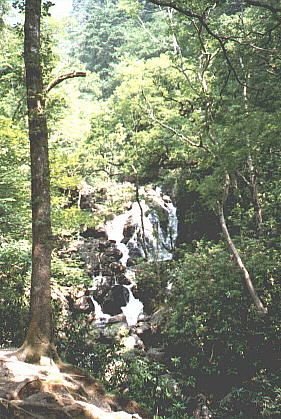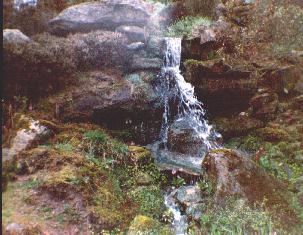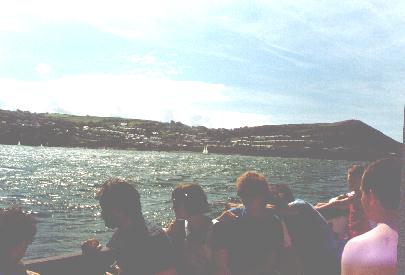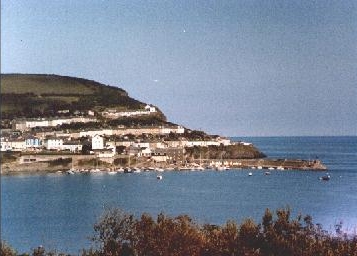Above left; looking up at the village from a riverside viewpoint. Left; One of the streets of the Piazza. The woman in the red jacket centreshot is Teri. David and Gabby were about 10 and 6 respectively.

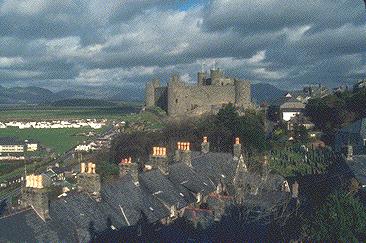 Moving south is the forbidding bastion of Harlech Castle not as spectacular as some but well preserved and reached from Conwy by a wonderfully scenic drive around the estuary and through the Snowdonia national park.
Moving south is the forbidding bastion of Harlech Castle not as spectacular as some but well preserved and reached from Conwy by a wonderfully scenic drive around the estuary and through the Snowdonia national park.
Harlech is known of course for the patriotic song Men of Harlech, sung with great fervour by Welsh supporters at international sports fixtures of all kinds.
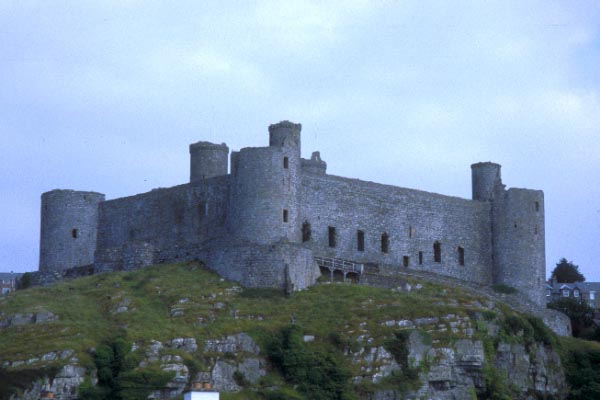
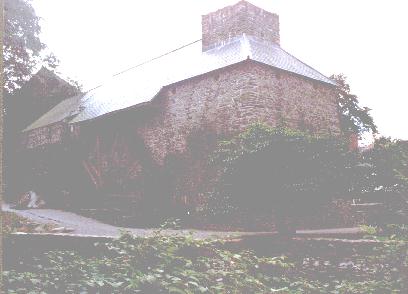
Close by Harlech we come to the village of Tal - y - Bont where visitors can look around a traditional craft centre which includes the fully restored water mill powered by the wheel pictured right.
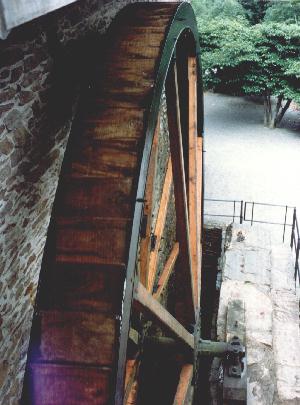
There are many such centres around these remote parts of Wales. Hill farming has never provided a life of luxury for those engaged in it and when the associated cottage industries, spinning and weaving of local wool and knitting were overwhelmed by the mechanisation of textile manufacture traditional industries such as mining and quarrying went into decline there was little employment. Social changes meant less people could earn a living in domestic service. The population declined throughout the first half of the twentieth century.
Eventually a more enlightened attitude from government led to the promotion of tourism and related industries and subsidies were awarded to people willing to engage in local crafts. A few miles inland there is an experimental low-tech community. People willing to eschew modern comforts live and work in buildings powered by solar energy and water driven turbines, use ecologically friendly methods to make a living and have made many contributions to technology including a very efficient method of home insulation.
The next landmark is Cadair Idris, a dark, glowering mountain that dominates the landscape for many miles. There is a legend that I do not know very well, of a giant buried under the mountain. No doubt the foolish hulk got on the wrong side of some Welsh sorcerer or Goddess.
Left; looking north over the Mawddach estuary towards the mountain. Right: The town of Dolgellau, featured in the story.

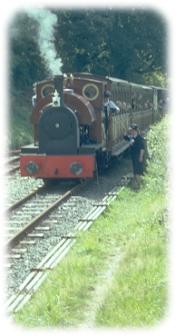 Continuing south is the small resort of Tywyn (not to be confused with a much larger town of the same name in North Wales) and the main attraction here is another narrow gauge railway, the Tall-y-Llyn line which makes its way into the Druid heartland to the village of Abergynolwyn (don't you love the place names, they alone make the crazy rush of modern life seem a million light years away.
Continuing south is the small resort of Tywyn (not to be confused with a much larger town of the same name in North Wales) and the main attraction here is another narrow gauge railway, the Tall-y-Llyn line which makes its way into the Druid heartland to the village of Abergynolwyn (don't you love the place names, they alone make the crazy rush of modern life seem a million light years away.
The area inland from Tywyn is the place I had in mind when describing the scenery of Mogwydd's world. My father was a newspaper man and based in the border town of Shrewsbury covered all of this area. Each summer we would rent a house on this coast for the long vacation and he would cover the various events. I loved the villages, hills, waterfalls, beaches and other rural attractions and obviously they made a deep impression.
Do you begin to get the impression that I like waterfalls?

Follow the coast around the wide sweep of Cardigan Bay and the next important town is Aberystwith, ancient capital of Wales and now an important administrative centre and home of the University of Wales. The Castle here is almost ruined but the town is worth a visit and is the coastal terminus of the Devils Bridge railway. We will not be visiting that because you can have too much of a good thing so we will take the road route instead.
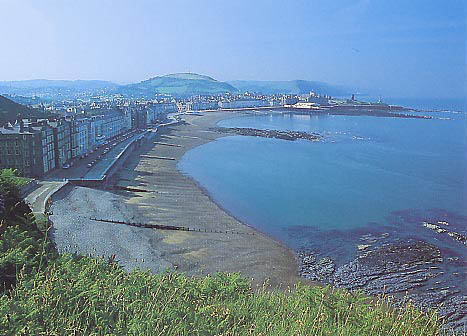
If the weather is bad when you are in Aberystwyth I can tell you of an extra entertainment that I played as a child and later took my children to experience. At high tide go to the southern end of the of the seafront, near the castle grounds. Here the waves will crash against the sea wall sending spray flying onto the promenade or broadwalk. Wait for the big waves coming in and then run, carefully timing your retreat to avoid getting sprayed (as if). It sounds idiotic but is great fun.

Continuing south from Aberystwith and passing through many picturesque one - time fishing and now holiday villages the next town of any size is Cardigan but before we get there I must take you on a short excursion. About half way between the two towns you will pass a signpost for Cei Newydd. "Probably another small attractive place of no significance" you might think. Think again.
For lovers of books and poetry Cei Newydd is well worth the two or three mile drive along the headland on which it is situated. When the road reaches the top of the town it almost doubles back on itself to follow the coastline back towards the main Aberystwith - Cardigan route.If you wish to see the village (and you do, trust me) we can take one of the two narrow streets that slope steeply down towards the harbour. While deciding which looks more attractive you notice a small chapel to your left, sitting on a wooded hillside. Maybe there was once a minister named Rev. Eli Jenkins who used to stand outside his Manse under a starry sky and declaim his poems to the heavens.
Maybe the chapel is called Bethesda Chapel. Maybe not.
We start to walk down the busier of the two streets, past a large shop that now sells all manner of seaside paraphernalia but perhaps was once a drapers emporium. There is almost a sense of deja vu as we walk on.
What is the name of that large public house halfway down the hill, could it be the Sailor's Arms and prim guest house with the owner's name above the door. Could it be Ogmore - Pritchard?
You have arrived in the model for Llareggub (buggerall spelt backwards) the fictional village in Dylan Thomas' famous play for voices, Under Milk Wood. Thomas lived here for a while and the insular nature of small communities at that time (only just over fifty years ago) revealed to him that people have much more in common than that which divides us.
Everywhere I have been, in Europe and America, I have seen the same characters as appear in Under Milkwood; Mog Edwards the opportunist, Myfanwy Price the lovestruck singleton, Dia Bread the womaniser, Mr Waldo the drunk, Nogood Boyo the waster, old Captain Cat lost in madness and memories, Polly Garter the trollop, Mrs Ogmore Pritchard the harridan still nagging paying guests and the ghosts of her dead husbands, Gossamer Beynon the dreamer and Willy Nilly the nosey postman (mailman) who steams open letters and tells the townspeople what has been written to them as he delivers the mail.
They crop up in the works of Shakespeare, Arthur Miller, David Mamet, Goethe and all the other great writers. I have read critics who say that fiction is dead because there is nothing new to say about the human condition. In fact there never has been, the truths are universal. But there are always new and entertaining ways of revealing them.
Pictures: Top, Ceinewydd from the sea; Middle, From the clifftop looking across the bay,Bottom; The harbour is a popular gathering place for sailing enthusiasts and many yacht are moored here throughout the summer months. This one is heading for the picturesque harbour which I thought I had many photographs of. I was wrong.

 |
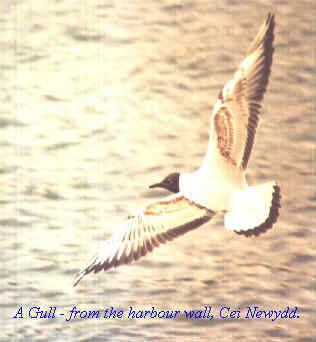 |
"Hold on Ian" you may think, this is no time to be showing you family holiday photographs. I know, but of all the wonderful times we had here I must share this story with you. There is a very long beach at Cei Newydd and at times small steams cascade down the cliffs and flow across the sand. When we started to come here I taught my kids a game I used to play as a child, making dams. Now in the 1950s the sand was virtually deserted but twenty five years later the beach was a magnet for picnickers.
The things you have to remember in this game are that sand dries very quickly and also that dams made of sand do not last long. Our idea of a picnic was very casual, a sandwich or burger from the beach shop, ice cream, that was it. Some people take their picnics more seriously.
One day we had built a superb dam with interlinked channels, big stones to reinforce it and an overflow which shifted the natural stream a few yards further along.
A family of serious picknickers came along and decided a good place to spread their groundsheet, lay out the plastic plates and cutlery and distribute the tupperware containers of various salads, pies, cooked meat and bread was right where, but for our intervention, the stream normally flowed down the beach.
We would have warned them, honestly we would but everyone was preoccupied with an eel Gabrielle had caught in her little plastic bucket. Now as I said these people were serious picnickers, not the type of folk who were built for moving quickly. When the dam broke and water surged towards the elaborate spread the entire beach seemed to be transformed into a mass of enormous bottoms performing some kind of dervish dance as they leaped and ducked trying to salvage their precious food. "Do you know who did this," they demanded of us. Teri and I, lips clamped tight to suppress laughter shook our heads earnestly. The kids, far better actors of course, said without a flicker of guilt, "yes, it was some big kids. They've gone now."
The last we saw of the picnickers was a fleet of bottoms marching away in battle formation, determined to claim any reliably waterless patch of sand they saw.

A recording of "Under Milk Wood" may still be available from the Polygram Spoken Word Catalogue. Alternatively search on the title or "Dylan Thomas" The BBC (British Broadcasting Corporation) is a good place to look too. Use the site's internal search engine to find details of BBC audio and video products.
NEXT PAGE
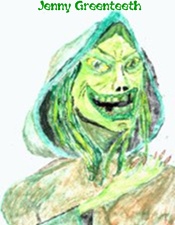 Greenteeth Labyrinth
Greenteeth Labyrinth
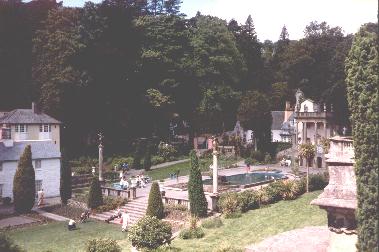
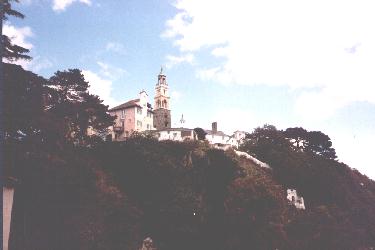
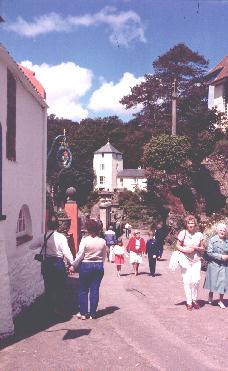

 Moving south is the forbidding bastion of Harlech Castle not as spectacular as some but well preserved and reached from Conwy by a wonderfully scenic drive around the estuary and through the Snowdonia national park.
Moving south is the forbidding bastion of Harlech Castle not as spectacular as some but well preserved and reached from Conwy by a wonderfully scenic drive around the estuary and through the Snowdonia national park.


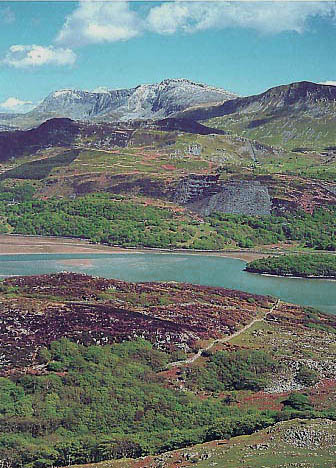
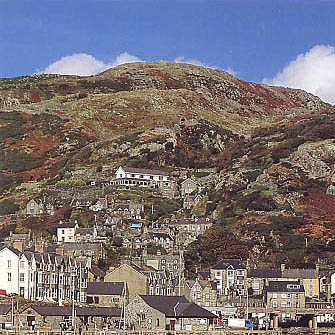
 Continuing south is the small resort of Tywyn (not to be confused with a much larger town of the same name in North Wales) and the main attraction here is another narrow gauge railway, the Tall-y-Llyn line which makes its way into the Druid heartland to the village of Abergynolwyn (don't you love the place names, they alone make the crazy rush of modern life seem a million light years away.
Continuing south is the small resort of Tywyn (not to be confused with a much larger town of the same name in North Wales) and the main attraction here is another narrow gauge railway, the Tall-y-Llyn line which makes its way into the Druid heartland to the village of Abergynolwyn (don't you love the place names, they alone make the crazy rush of modern life seem a million light years away.